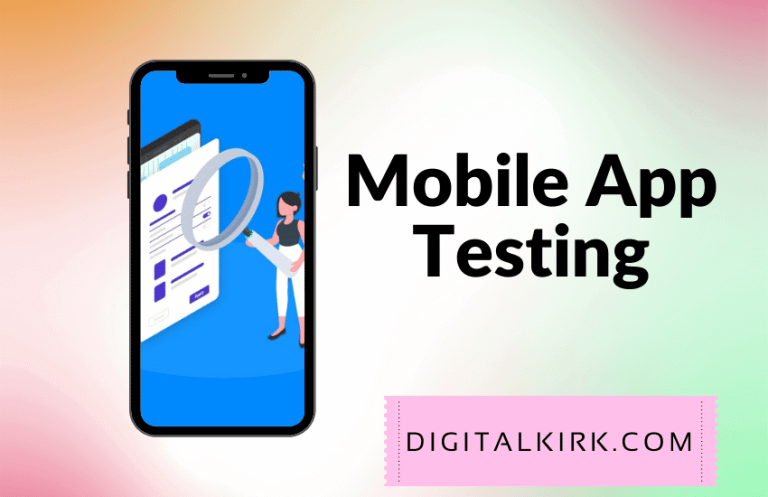Mobile as well as mobile applications are becoming an integral component of everyday life. Consumers all over the world are expected to download 187 billion mobile applications from the Google Play Store in 2025, up from 109 billion apps in 2020, according to a research. As a result, the market value of high-quality mobile applications is increasing at the moment. As a result, it is now crucial for IT organizations to make sure that all of their mobile applications provide smooth transactions and provide a fantastic user experience (UX), and that is when mobile app testing comes into being.
What Is Mobile App Testing?
Mobile app testing, as the name indicates, is the procedure of evaluating a mobile app (iOS as well as Android) for its functioning and usability prior to its distribution to the general public. Application testing enables users to confirm if a mobile application satisfies the desired technical and commercial criteria.
Teams must test applications on various operating systems, network bandwidths, and screen resolutions in order to do effective mobile app testing. As a result, when the software or the mobile applications is made available to the general public, it will operate perfectly on a variety of device setups.
Why Is Testing Mobile Apps Important?
Creating mobile applications has as its ultimate objective expanding corporate reach to more customers worldwide. However, if the software is broken or challenging to use, people are unlikely to utilize it. Naturally, no organization would want its clients to remove their applications and use a rival.
If mobile applications are not fully tested, there is a great likelihood that users could run into serious issues on their device, which might make for a poor user experience—especially for novice users. You must keep in mind that each mobile app’s success depends largely on its initial impression. Any unanticipated app crash or fault in the operation of the program might result in its instant deletion. Additionally, this causes the loss of prospective clients and income.
What procedures are involved in testing mobile applications?
Let us have a glance at some of the procedures that are involved in mobile app testing.
- Determine the testing requirements: This is the first stage. The scope along with the test coverage, and what has to be tested in an app must all be decided by the testers.
- Choose the testing strategy: After determining all the testing requirements, testers must choose the testing strategy to be used for mobile applications. New mobile applications are put through a number of tests. This includes regression, functional, performance, and load testing, interruption, speed, usability, localization, security, and accessibility tests, among others.
- Create test cases and test scripts: Writing test cases and automated test scripts is the next stage. The test cases for an app should include all of its crucial features and functional areas, according to testers.
- Plan to automate/manually execute: Testers must choose whether to automate or manually run the test based on the demands of the test. To speed up releases and to guarantee a quicker time to market, testers must use automated mobile testing solutions in accordance with testing specifications.
- Track and manage the defects and errors: After the testers have completed all the test cases, they must find the problems in an app and resolve them as quickly as possible.
- Finally, testers are required to provide a test execution report that lists all the test cases that passed or failed, the issues that were found and fixed, and additional notes. All interested parties must get the report in order for them to make informed choices.
We must not forget that in today’s fast-paced world, an application must function flawlessly on all marketable hand-held devices in order to be successful on the market. Testing mobile applications across all conceivable platforms is challenging for testers, however. As a result, for mobile app testing, testers must make use of both actual devices and virtual devices (simulators and emulators).
Ways To Identify Instances That You Need Automation Testing
Mobile app testing is a must. Here are some instances when you would know that your application requires testing at the earliest.
-
Costs of the in-house device lab
Hopefully, your mobile application will slowly begin to take the market over time. The tester will have more testing duties once such a phase has arrived. As a result, organizations prefer to purchase their own mobile devices, which drives up the cost of the in-house device lab. Despite being a wise and beneficial investment, it is undoubtedly noted in bold on the expenditure sheet.
We now need more personnel to maintain the grid, which increases the expense of our internal device lab. If we don’t bring in experts, testing will take longer overall, and delivery will be delayed. Maintaining the current pattern may cast doubt on the testing technique and procedures.
Device lab expenses are a major factor in the high costs associated with doing mobile testing. The higher device lab expenditures won’t be a one-time event if the responsibilities keep expanding as the releases go on.
-
To encourage emotional involvement
Pokemon GO, a mobile game that was launched previously, serves as an example of the value of emotional involvement for mobile applications. There are hundreds of applications providing the same concepts in the mobile age, but just a select few command the lion’s share of the market. There’s no assurance that someone will use your app often, even if you can convince them to download and install it. Many applications are deleted after just one usage. This engagement can only be generated via mobile app testing, which is crucial for developing hooks and tactics to get users to return. You must utilize a representative sample of end users outside the development team to evaluate the emotional involvement of your app.
-
When you see an increase in the length of your mobile testing cycles?
The deployment of mobile test automation may be a potential solution if your test cycles are continuously becoming longer and having an influence on the project delivery schedule. This is an indication that you are wasting too much time on something repetitive. It is crucial that you complete the project by the deadline as the owner or developer of the mobile application. Delivering the software more quickly is the key to beating out the competition in the market. Test cycles start to lengthen beyond what the testers can endure, and they get heavier. Mobile test automation may help with this. A smart technique to keep project expenses under control is via automation. Although it may cost more, mobile test automation offers a decent return on investment over time.
Imagine you have a project that requires 48 hours of testing. If your tester worked eight hours a day at the office, it would take six days to finish. The automation doesn’t have to go home and unwind. Mobile test automation may run for 24 hours a day (in the best circumstances) while your resources are not in use, and you are finished in only one day. Of course, this can only be true in circumstances where there is no longer a need for human involvement.
Mobile test automation may participate in test cycles and automate a few fixed, repeatable test cases that don’t need human labor. The project deliverables will become immediate with automation managing a portion of your test cycles, and you may cut the test cycle duration by up to 98%.
-
Determine the Proper Platform
Your test technique will vary depending on whether your software is native, web-based, or a combination of the two. The greatest control over the experience is provided by a native app, but owing to the variety of device hardware and operating systems, maintaining it across different platforms requires a lot more work.
Testing web-based applications involves unique difficulties. In the age of responsive and adaptable Web design, you’ll need to deal with a variety of browsers (natively created for the device or conventional browsers), performance/load testing, and maybe most crucially, how the app performs with varied device screen sizes. You must have the necessary testing knowledge on your team, regardless of the platform you test.
-
Stagnant Business Growth
The testing procedure often takes 50% or less of the allotted time, and this is also true for mobile testing projects. The time may increase by as much as 75%, according to some reports. That much time has passed. The issue arises when trying to spread your wings in other areas, despite the fact that one can believe they are able to complete the job by the deadline.
The software sector is one where the market is always changing. People may like skeuomorphic designs now, but they may someday become fans of flat design.
The product must be altered continuously in order to keep up with these developments and to investigate them. But if all of the time is devoted to project testing, there won’t be any left over to analyze the market or come up with fresh ideas.
With automated mobile testing, we can complete repeated mobile testing activities fast, allowing us to complete the testing phase more quickly. Then, this time may be used to work on other tasks and do study for our company’s next phase.
This stage does not begin on day one, however. When a project begins to expand, we often start spending a lot of time on the testing phase. Our analysis of the anticipated increase and mobile test automation would come next.
You can test your mobile applications with LambdaTest – a continuous testing platform that offers actual devices and simulators and emulators. Using LambaTest’s online real device cloud, you can perform tests on many devices. Your native applications may be tested manually or automatically with LambdaTest on a variety of 3000+ Android and iOS devices. This makes it easier to replace your pricey testing methods with a cloud-based mobile testing platform that is more dependable and compatible with testing on actual hardware.
Conclusion
The worldwide market for mobile apps is expanding quickly and changing as a result of technology. In order to provide a fantastic UX, every company nowadays requires high-quality mobile applications. These mobile applications should be evaluated for their usability, performance, security, and other factors. In order to create high-quality mobile applications, organizations should use end-to-end mobile app testing from a next-generation QA and an independent software testing services provider.

